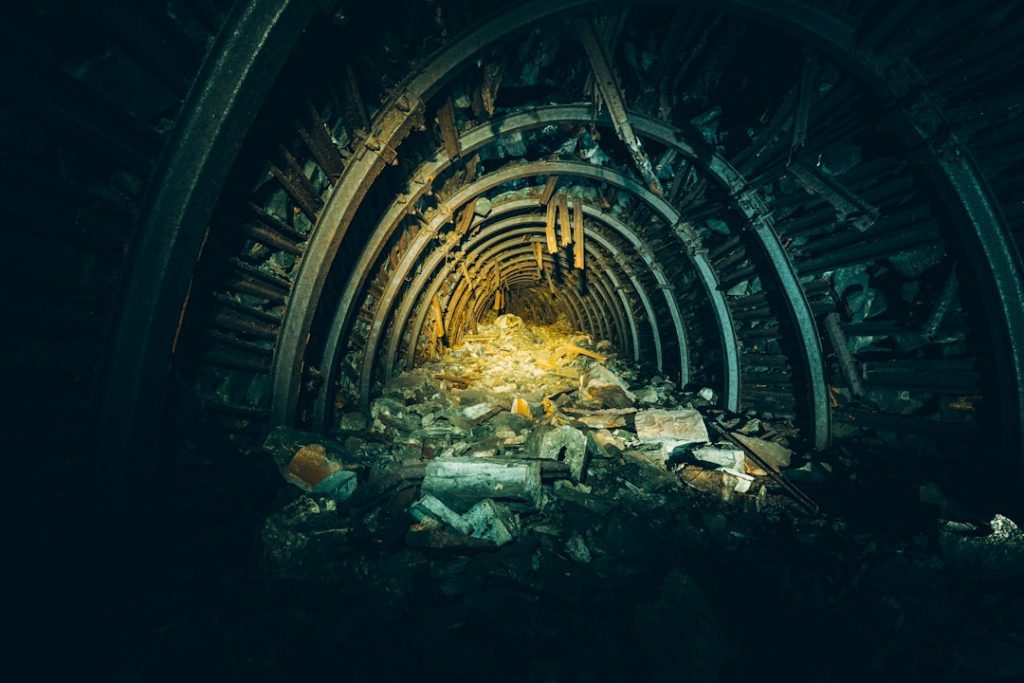Coal extraction, also known as coal mining, is the process of obtaining coal from the ground. It plays a crucial role in the energy industry, as coal is a major source of fuel for electricity generation and heating. The extraction process employs various methods, including surface mining and underground mining, to access coal deposits.
Surface mining techniques, such as strip mining and mountaintop removal, involve removing topsoil and rock layers to expose coal seams. Underground mining, on the other hand, requires the excavation of tunnels and shafts to reach coal deposits deep within the earth. Coal extraction has been an integral part of human civilization for centuries, providing a reliable energy source for industrial and domestic purposes.
However, the process has significant environmental impacts that must be considered. These include air and water pollution, deforestation, and habitat destruction. The environmental consequences of coal extraction extend beyond the immediate area, affecting local communities’ health and well-being.
Understanding and addressing these impacts is essential for developing sustainable and responsible coal extraction practices.
Key Takeaways
- Coal extraction is the process of removing coal from the ground for use as a fuel source.
- Coal extraction contributes to air pollution through the release of particulate matter, sulfur dioxide, and nitrogen oxides.
- Water resources can be negatively impacted by coal extraction through contamination from mining activities and the release of toxic substances.
- Deforestation and habitat destruction are common consequences of coal extraction, leading to loss of biodiversity and ecosystem disruption.
- Local communities near coal extraction sites can experience health issues such as respiratory problems and water contamination.
Effects of Coal Extraction on Air Quality
Airborne Particulate Matter
One of the most significant contributors to air pollution from coal extraction is the release of particulate matter, which includes tiny particles of ash, soot, and other pollutants. These particles can be easily dispersed into the air, leading to respiratory issues and other health problems for both humans and wildlife.
Acid Rain and Smog Formation
Additionally, coal extraction and combustion release sulfur dioxide and nitrogen oxides, which can contribute to the formation of acid rain and smog, further degrading air quality. Furthermore, the extraction process often involves the use of heavy machinery and explosives, leading to additional emissions of dust and pollutants into the air.
Widespread Impact and Mitigation
The transportation of coal from mining sites to processing plants and power stations also contributes to air pollution through vehicle emissions. Overall, the impact of coal extraction on air quality is significant and widespread, affecting not only the immediate vicinity of mining operations but also neighboring communities and ecosystems. It is crucial for coal extraction operations to implement effective pollution control measures to minimize these harmful effects on air quality.
Impact of Coal Extraction on Water Resources

Coal extraction can have detrimental effects on water resources through various mechanisms, including water pollution, depletion of water sources, and disruption of aquatic ecosystems. One of the primary concerns related to coal extraction is the contamination of water sources with heavy metals, sediment, and other pollutants. Surface mining activities, such as strip mining and mountaintop removal, can lead to the release of toxic substances into nearby rivers, streams, and groundwater.
This pollution can have severe consequences for aquatic life and can also affect the quality of drinking water for local communities. In addition to water pollution, coal extraction can also contribute to the depletion of water sources in water-stressed regions. The extraction process often requires large quantities of water for activities such as dust suppression, equipment cooling, and coal processing.
This high demand for water can strain local water supplies, especially in areas where water resources are already limited. Furthermore, the disturbance of land and vegetation during coal extraction can lead to increased erosion and sedimentation in water bodies, further impacting aquatic habitats and water quality. It is essential for coal extraction operations to implement sustainable water management practices to minimize their impact on local water resources.
Deforestation and Habitat Destruction from Coal Extraction
| Country | Deforestation Rate (hectares per year) | Loss of Habitat (hectares per year) |
|---|---|---|
| United States | 10,000 | 8,000 |
| China | 15,000 | 12,000 |
| India | 7,000 | 5,000 |
The process of coal extraction often involves clearing large areas of land for mining operations, leading to deforestation and habitat destruction. In surface mining methods such as mountaintop removal, entire forests are cleared to access coal deposits beneath the surface. This extensive deforestation not only removes valuable carbon sinks but also disrupts wildlife habitats and biodiversity.
The loss of forest cover can have far-reaching ecological consequences, affecting soil stability, water retention, and the overall health of ecosystems. Furthermore, the infrastructure associated with coal extraction, including roads, railways, and processing facilities, can fragment and degrade natural habitats. This fragmentation can isolate wildlife populations, disrupt migration patterns, and increase the risk of human-wildlife conflicts.
Additionally, the noise and disturbance from mining activities can further impact wildlife behavior and reproductive success. It is crucial for coal extraction operations to consider the ecological impact of their activities and implement measures to minimize deforestation and habitat destruction. This may include reforestation efforts, habitat restoration projects, and the implementation of wildlife corridors to mitigate the impact on local ecosystems.
Health Effects of Coal Extraction on Local Communities
The environmental impact of coal extraction extends beyond ecological concerns to include significant health effects on local communities. The release of air pollutants such as particulate matter, sulfur dioxide, and nitrogen oxides from coal extraction and combustion can lead to respiratory problems, cardiovascular diseases, and other health issues for nearby residents. These pollutants can exacerbate existing health conditions such as asthma and bronchitis and can also increase the risk of lung cancer and other respiratory illnesses.
In addition to air pollution, water contamination from coal extraction can also pose serious health risks for communities that rely on local water sources for drinking and irrigation. Exposure to heavy metals and other pollutants in drinking water can lead to a range of health problems, including neurological disorders, gastrointestinal issues, and developmental abnormalities in children. Furthermore, the disruption of natural ecosystems due to deforestation and habitat destruction can impact food security and access to natural resources for local communities.
It is essential for coal extraction operations to prioritize the health and well-being of nearby communities by implementing measures to minimize pollution and protect water sources.
Greenhouse Gas Emissions from Coal Extraction

Direct and Indirect Emissions
In addition to direct emissions from combustion, coal extraction activities such as transportation, processing, and waste management also contribute to greenhouse gas emissions.
Methane Release and Safety Risks
Furthermore, the process of extracting coal itself can release methane, a potent greenhouse gas, into the atmosphere. Methane is often trapped within coal seams and can be released during mining operations. This methane release not only contributes to climate change but also poses safety risks for miners due to its flammability.
The Need for Sustainable Energy Sources
The cumulative impact of greenhouse gas emissions from coal extraction underscores the urgent need to transition towards cleaner and more sustainable energy sources. Renewable energy alternatives such as solar, wind, and hydroelectric power offer viable solutions to reduce greenhouse gas emissions and mitigate the impacts of climate change.
Solutions to Mitigate the Environmental Impact of Coal Extraction
Addressing the environmental impact of coal extraction requires a multi-faceted approach that encompasses technological advancements, policy interventions, and community engagement. One key solution is the implementation of advanced pollution control technologies at coal-fired power plants to reduce emissions of particulate matter, sulfur dioxide, nitrogen oxides, and mercury. These technologies include electrostatic precipitators, flue gas desulfurization systems, selective catalytic reduction systems, and activated carbon injection systems.
In addition to pollution control measures, transitioning towards cleaner energy sources such as renewable energy can help reduce reliance on coal for electricity generation. Investing in solar power, wind energy, hydroelectric power, and other renewable technologies can significantly reduce greenhouse gas emissions and minimize environmental impacts associated with coal extraction. Furthermore, promoting energy efficiency measures in industrial processes and buildings can help reduce overall energy demand and lessen the need for coal as a primary fuel source.
Policy interventions are also crucial in mitigating the environmental impact of coal extraction. Governments can implement regulations that require coal extraction operations to adhere to strict environmental standards for air and water quality protection. Additionally, financial incentives such as tax credits or subsidies can encourage investment in clean energy technologies and support the transition away from coal-based energy production.
Community engagement is essential in addressing the environmental impact of coal extraction. Local communities affected by mining operations should be involved in decision-making processes and have a voice in shaping sustainable development plans. This may include initiatives such as community-led reforestation projects, sustainable land use planning, and support for alternative livelihoods that are less reliant on coal extraction.
In conclusion, while coal extraction has been a significant source of energy for centuries, it is essential to recognize its substantial environmental impacts. From air and water pollution to deforestation and habitat destruction, the consequences of coal extraction are far-reaching and require urgent attention. By implementing advanced pollution control technologies, transitioning towards renewable energy sources, enacting supportive policies, and engaging local communities, it is possible to mitigate the environmental impact of coal extraction while ensuring a sustainable energy future for generations to come.
FAQs
What is coal extraction?
Coal extraction is the process of removing coal from the earth’s surface or underground. This can be done through various methods such as surface mining or underground mining.
What are the different methods of coal extraction?
The two main methods of coal extraction are surface mining and underground mining. Surface mining involves removing the topsoil and rock layers to access the coal seams, while underground mining involves digging tunnels and shafts to reach the coal deposits.
What are the environmental impacts of coal extraction?
Coal extraction can have significant environmental impacts, including habitat destruction, air and water pollution, and the release of greenhouse gases. Surface mining can also lead to deforestation and soil erosion.
What are the safety concerns associated with coal extraction?
Coal extraction can be a dangerous occupation, with risks of accidents, injuries, and exposure to harmful substances such as coal dust and methane gas. Proper safety measures and regulations are essential to protect the workers involved in coal extraction.
What are the uses of coal extracted from the earth?
Coal extracted from the earth is primarily used for electricity generation and industrial processes such as steel production. It can also be used for heating and in the production of various products such as plastics and chemicals.



